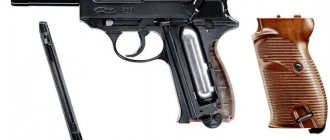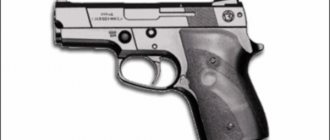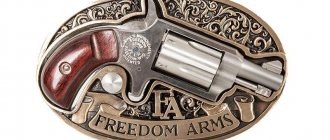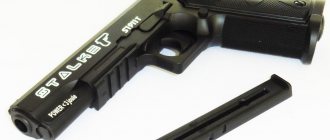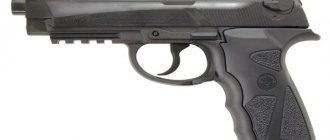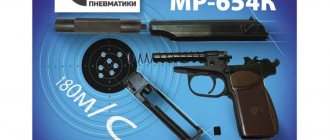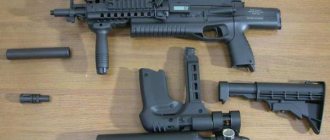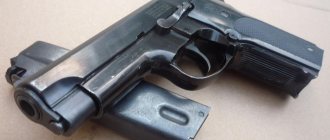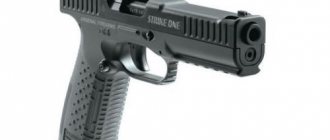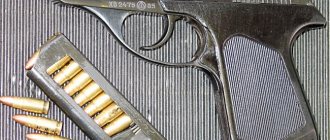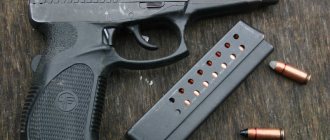| Walther P.P. | |
| Walther P.P. | |
| Type | Self-loading pistol |
| A country | Germany |
| Service history | |
| Years of use | since 1929 |
| Adopted | 1935 |
| In service | Germany/Germany |
| Wars and conflicts | The Second World War |
| Production history | |
| Constructor | Walther |
| Designed by | 1929 |
| Manufacturer | Walther |
| Total issued | more than 1 million |
| Characteristics | |
| Weight, kg | 0,682 |
| Length, mm | 170 |
| Width, mm | 30 |
| Height, mm | 100 |
| Cartridge | 7.65x17mm, 9x17mm .22LR, 6.35x15mm |
| Work principles | blowback recoil |
| Maximum range, m | 25 m |
| Type of ammunition | magazine for 8 rounds 7.65×17 mm 7 rounds 9×17 mm |
| Aim | constant |
| Media files on Wikimedia Commons | |
| Walther PPK | |
| Walther PPK | |
| Type | Self-loading pistol |
| A country | Germany |
| Service history | |
| Years of use | since 1931 |
| Adopted | 1935 |
| In service | Germany/Germany |
| Wars and conflicts | The Second World War |
| Production history | |
| Constructor | Walther |
| Designed by | 1931 |
| Manufacturer | Walther |
| Characteristics | |
| Weight, kg | 0,590 |
| Length, mm | 155 |
| Barrel length, mm | 83 |
| Width, mm | 25 |
| Height, mm | 109 |
| Cartridge | 7.65×17 mm, 9×17 mm .22LR, 6.35×15 mm |
| Work principles | blowback recoil |
| Type of ammunition | 7-round magazine 7.65×17 mm 9 rounds .22 LR |
| Aim | constant |
| Media files on Wikimedia Commons | |
Walther PP, Walther PPK
- German self-loading pistols, developed by , one of the first mass-produced pistols with a double-action trigger.
Story
Model PP (German Polizeipistole - police pistol) was released in 1929.
In 1931, a shortened and lightweight model of the Walther RRK (German Polizeipistole Kriminal - criminal police pistol) appeared, which was a PP reduced in size, but also had some original design features. The barrel length was reduced by 15 mm, the overall length by 16 mm, and the height by 10 mm. Accordingly, the design of the frame and the shutter-casing was slightly changed, receiving a different shape for the front part.
After the war, pistols were not produced for some time, but in the early 1950s they began to be manufactured in France and Germany.
In the 1960s, it resumed production of the PP and PPK models, which continued until the end of the 20th century.
In addition, the production license was sold to the USA, in 1978 the production of pistols was started for, and after its closure, in 2002, by Smith & Wesson. In the United States, Walther branded weapons are sold by Walther Arms, Inc., a subsidiary of PW Group located in Fort Smith, Arkansas.
Currently, the Walther PPK is produced in two versions - “PPK” and “PPK/S” chambered for the 9x17 mm cartridge, as well as in the small-caliber version “PPK/S .22” chambered for the .22 Long Rifle[1].
P38 Pistol Specifications
The Walter P38 was produced in several different versions. They differ from each other in geometric dimensions, weight and some other parameters.
The performance characteristics of the most common option are as follows:
| Gun weight | 880 grams (770 in post-war version with aluminum frame) |
| Barrel length | 125 millimeters |
| Overall length of weapon | 216 mm |
| Height | 136 mm |
| Width | 37 mm |
| Sighting range | 50 meters |
| Nutrition | Magazines for 8 rounds of 9x19 mm |
At a distance of 200 meters, bullets fired from this weapon still retain their destructive power.
Device
9-mm Walther PPK - incomplete disassembly
The operation of the Walther RR and RRK automatics is based on blowback recoil.
The pistol consists of 51 parts.
Double action trigger with an open hammer with a round hole in the spoke. The mainspring is twisted, cylindrical, located in the handle. Trigger force when the hammer is cocked is 2.7 kg, in self-cocking mode - 5.9 kg. The trigger rod is located on the right in the frame slot and is closed by the bolt.
The fuse is located on the left side of the bolt housing. To turn off the safety, its flag must be moved to the upper position (like other German pistols “Parabellum” and Walther P38). When the safety is turned on, the hammer is automatically released from the cocking position, the hammer is released safely and the hammer is locked. The trigger and firing pin are also blocked. In this case, the bolt is not blocked and the weapon can be reloaded when the safety is on.
A feature of the trigger is that when the safety is engaged with the hammer not cocked, the trigger remains in the forward position, and when the hammer is cocked it remains in the rear position. When the safety is removed, the trigger takes the forward position. You can observe how, after safely releasing the trigger, especially those who have used a pistol, turn the flag up and down again so that the trigger takes the forward position, natural when the trigger is pulled. There is no such ambiguity in the PM pistol.
The developers of the Walter PP abandoned the Koltov safety cocking in the USM in the form of an additional tooth on the trigger. This later became a distinctive feature of German pistols. The circuit with a trigger and firing pin disconnector ensures reliability and greater safety in handling the weapon, although it complicates the design.
Protection from a shot when the weapon falls is provided by a vertically located, spring-loaded disconnector of the hammer and firing pin. The trigger cannot act on the striker until the sear is raised by the disconnector. The broken trigger stops in front of the firing pin with a protrusion of the disconnector. Removal of the trigger lock occurs only after the trigger has been completely moved, when the disconnector rises and with its protrusion takes a position opposite the groove on the surface of the trigger.
To prevent a premature shot, the trigger rod has a protrusion on which the bolt acts when it does not reach the locking position, separating the rod and the sear. The upward movement of the hammer disconnector and the firing pin when the trigger is pressed will be possible only when the bolt takes its extreme forward position and the trigger is released so that the rod is placed under the sear.
The magazine is single-row; the magazine latch on most pistols is located on the left side of the frame, behind the trigger axis, and looks like a button. However, there were other options - with a magazine latch located at the base of the handle. There is an indicator of the presence of a cartridge in the chamber in the form of a pin that protrudes from the rear side of the bolt above the trigger head.
After the cartridges in the magazine run out, the bolt will engage the bolt stop in the rear position. After changing the magazine, the bolt needs to be pulled back a little and released. The bolt will be released from the delay and, under the action of the return spring located around the barrel, will send the cartridge into the chamber. The weapon will be ready to fire again.
There is no bolt stop lever, so it is impossible to remove the bolt from the delay without removing the empty magazine. Before removing the delay, you must either remove an empty magazine, or remove and insert an empty magazine or a loaded one.
The frames of all 9 mm Walther PPK pistols produced today differ from the original German ones in the presence of an elongated rear protrusion that protects the shooter's hand from being hit by the hammer head or bolt when firing. In February 2009, an automatic firing pin safety device was introduced into the Walther PPK design to improve safety during handling.
Operating principle of Walther P38
The mechanism that ensures automatic reloading of the Walter P38 pistol works as follows:
- The shooter pulls the bolt group back;
- The pistol magazine feed spring pushes the cartridge up;
- Moving back under the influence of return springs, the bolt “picks up” the cartridge and pushes it into the chamber;
- The swinging cylinder rises, engaging the bolt and barrel;
- The shooter presses the trigger, a shot occurs;
- Under the pressure of the powder gases, the bolt begins to move backward;
- The swinging cylinder lowers, the bolt and barrel disengage;
- Continuing to move backward, the bolt compresses the return springs and brings the cartridge case to the window, after which it is ejected;
- The cycle repeats starting from point 2.
Walther P38 cutaway.
The cartridge is already moved forward, but the hammer is not cocked. The swinging cylinder is raised. Cocking the hammer before the first shot is carried out by the shooter himself at the moment of pulling back the bolt group; in the future, this operation occurs automatically. In addition, if there is a cartridge in the barrel, you can simply cock the hammer with your thumb.
Options and modifications
The Walther PP and Walther PPK pistols were produced in various modifications and versions chambered for four different calibers. The total number of pistols produced exceeded one million. The most widely produced pistols were chambered for 7.65×17 mm, the second was 9×17 mm, the third was .22LR (5.6 mm rimfire) and the rarest were pistols chambered for 6.35×15 mm Browning, of which there were Less than 1000 pieces were produced.
- Walther PP
(German: Polizeipistole) - “police” model model 1929[2]. In 1929-1945. About 200 thousand units were produced in Germany[3] - Walther PPK
(German: Polizeipistole Kriminalmodell) - compact model arr. 1931 with a barrel shortened to 83 mm[2], developed by order of the Prussian Ministry of the Interior. In 1931-1945. About 150 thousand units were produced in Germany[3] - Walther PPK-L
- modification of Walther PPK with an aluminum alloy frame, developed in Germany in the 1950s - Walther PPK/S
is an export modification of the Walther PPK chambered for 9x17 mm, developed for the United States after the import of Walther PPK was stopped in 1968 in accordance with legislative changes (which established the minimum size of imported civilian pistols at 101 mm). Produced in Germany and under license in the USA. It was a combined version, combining the frame of a RR pistol and a shortened barrel and bolt of the RRK[4]. - Walther PP Super
- modification of Walther PP chambered for 9x18 mm Ultra[2]. Developed in 1972. - Walther PPK/E
- a modification of the Walther PPK, produced for 7.65x17 mm, 9x17 mm and .22 LR cartridges.
In addition, copies and clones of Walther PP and Walther PPK pistols were produced in a number of countries:
- in the Hungarian People's Republic, since 1948, the FÉG arms factory produced the 48M
(a copy of the Walther PP chambered for 7.65×17 mm with minor design changes) [5], they had a modified automatic safety design, a different indicator of the presence of a cartridge in the chamber, a protrusion on the magazine feeder (with the help of which the shutter was stopped after all the cartridges were used up) and lining on the handle with the coat of arms of the Hungarian People's Republic[6] - in Turkey, MKEK produces copies of Walther PP chambered for 7.65x17 mm and 9x17 mm[7]
- in 1955, licensed production of exact copies of Walther PP and Walther PPK pistols chambered for 7.65×17 mm, 9×17 mm and .22 LR (under the name “ Walther-Manurhin
”) was started in France, at an armory in the city of Mulhouse[ 8], they were mass-produced from 1955 to 1989. - in the People's Republic of China, a 7.65mm copy of the Walther PPK was produced and in service since the early 1950s under the name "type 52".[9] In the 1980s, the 7.65-mm “type 64”, developed back in the 1960s, began to enter service with the army and police; it was a PPK with a trigger mechanism and a fuse modeled on the Soviet PM.[10] A copy of Walther PP is produced for export under the name Norinco PPN
[11] - The Walther PP and Walther PPK influenced the design of many compact blowback pistols developed after the end of World War II, including the Hungarian FEG PA-63, Argentine Bersa Thunder 380, Spanish Astra Constable, Czechoslovakian CZ50 and South Korean Daewoo DH380.
- At the competition 1947-1948. for a new pistol for the command staff of the Soviet Army, Soviet gunsmith designers F.V. Tokarev, S.G. Simonov, S.A. Korovin, I.Ya. Stechkin, K.A. Baryshev, P.V. Voevodin, I. I. Rakov, A. A. Klimov, G. V. Sevryugin, A. I. Lobanov, N. F. Makarov presented samples more or less similar to Walther PP. The automation operation scheme specified by the competition (free shutter) contributed to the use of similar design solutions. The German pistol was also tested under a competitive program - for comparison.[12]. The winner of the competition had the same layout and inherited some design solutions (hinged trigger guard as a shutter travel limiter), although it differed in many details (trigger design, fuse, many smaller differences). This became the reason for numerous disputes over whether the PM can be considered only a converted copy of “Walter”. Obviously, the answer depends on the a priori attitudes of the evaluator. Soviet and Russian sources defend the point of view that the differences are significant enough to be considered an independent design, albeit made “with an eye on” the German pistol[13]. Western sources, on the contrary, express the opinion that the two designs are substantially similar.
Traumatic, gas and pneumatic pistols
- Umarex Walther mod.
PPK is an 8mm gas pistol made of powder alloy. A splitter is installed in the barrel bore in order to exclude the possibility of firing a live cartridge. - Walther Super PP
is a 9 mm gas pistol chambered for 9 mm PA cartridge. Manufacturer: Enser-Sportwaffen (Germany). Made from lightweight aluminum alloy. A splitter is installed in the barrel bore in order to exclude the possibility of firing a live cartridge. - Umarex Walther mod.
PP is a 10-mm traumatic pistol chambered for 10×22 mm T, certified in the Russian Federation as a “
gas pistol with the ability to fire a rubber bullet
.”
Since July 1, 2011, the import of foreign-made traumatic pistols certified as a “ gas pistol with the ability to fire a rubber bullet
” to Russia has been stopped. - ERMA RR-T
is a 9-mm traumatic pistol chambered for the 9 mm PA cartridge, produced by , first introduced in 2010. Has an external resemblance to Walther PP. The shutter is made of steel, and the frame is made of black anodized aluminum alloy[14]. - ERMA 55P
is a 9-mm traumatic pistol chambered for 9 mm PA manufactured by . Similar in appearance to Walther PPK[15] - WALTHER PPK BOND 007 Starter flare pistol, chambered for Hilti cartridge.
- UMAREX WALTHER PPK/S
is a 4.5 mm pneumatic gas cylinder pistol produced by the German company Umarex[16]. The design of the pistol ensures the movement of the barrel housing and the cocking of the hammer after the shot.
Design Features
Despite the fact that one of the goals pursued by the developers of the Walther P38 was to create a weapon that was simpler in design than the Parabellum, they only partially succeeded in achieving this. There are 58 parts in the design of the pistol, which in itself is a lot, and many of them are quite small. The number of springs is 11, and this is even more than that of the Luger P08, which has 7 of them. The trigger mechanism is also no different in its simplicity.
Disassembled Walther P38 pistol. Many small details surprise those who are accustomed to weapons of a simpler design.
The pistol's magazine is small by modern standards: it holds 8 rounds. There are two return springs; they are located under the bolt, on the sides of the frame. Above the trigger you can see a small rod - this is an indicator that allows you to determine whether the gun is loaded or not. In the first case, the rod will be extended. There is a fuse on the left side of the bolt. When it is turned on, the trigger can be pulled - the firing pin will be separated from it and the shot will not fire.
Operating countries
- Germany: Walther PP and Walther PPK were in service with the police[17]
- Germany: Walther PP and Walther PPK were in service with police and intelligence officers, used as personal weapons by tank crews, Luftwaffe and German Navy officers, senior Wehrmacht officers[17], a number were transferred to the Reich Ministry of Justice as personal weapons for staff. Since 1944, Walther PP began to be issued to graduates of Wehrmacht officer schools[3]. Also, Walther PP and Walther PPK were used as award weapons for the highest ranks of the Third Reich[17].
- Great Britain: captured pistols were used during the Second World War (including by SOE agents and intelligence officers operating in occupied Europe) [6]; After the end of the war, 7.65 mm Walther PP pistols (under the name XL47E1
) were issued to British soldiers in Ulster for constant carry as a self-defense weapon[18]. Pistols remained in the warehouses of the mobilization reserve until the early 1980s[6]. - USSR: captured pistols were used during the Great Patriotic War; in the first post-war years, a small number of Walther PP and Walther PPK pistols were used in the diplomatic courier service, and some more were transferred to award funds and used as award weapons[3].
- Iran: about 2 thousand Walther PP chambered for 9x17 mm were purchased in 1938-1939. for the Iranian police, they were all marked in Farsi[19]
- Germany: from the moment of its creation, the West German police received Walther PP and Walther PPK pistols, produced in the Third Reich, and later a batch of 7.65 mm Walther-Manurhin pistols made in France [20]; Since 1956, the production of Walther PPK for the Bundeswehr began under the name P21 (used by the military police, the military counterintelligence service (MAD), military aviation pilots and couriers) [21]
- France: Walther-Manurhin pistols entered service with the French police
- Egypt: in 1958, the 9 mm Hungarian FEG 48M was adopted by the air force under the name Walam 48 (the coat of arms of the Arab Republic of Egypt was depicted on the left side of the slide of these pistols)[6]
- Sweden: A small number of Walther PP were purchased for the Swedish police, they were in service with certain categories of Swedish police until 2003-2004.[22]
- Indonesia: at least until 2007, a number of Walther PPKs were in service with commandos (the Komando Pasukan Katak group of swimmers and the Komando Pasukan Khusus special forces) [23]
- Ukraine: in the 1990s it was a reward weapon[24]; as of August 15, 2011, there were 90 pieces in the custody of the Ministry of Defense. 7.65 mm Walther PP pistols and 175 pcs. 7.65 mm Walther PPK pistols[25]
- Ireland: The Walther PPK officially remained in service with the Army Rangers into the 2000s[26]
- USA: a number of Walther PPKs were used by the US police[27]
In addition, even before the outbreak of World War II, pistols went on sale as civilian weapons and became widespread in various European countries.
UK use
After the war, the British used the 7.65mm Walther PP with MI5, MI6 and the police as their main service pistol until the early 1970s.[28]
British SAS soldiers used Walther PP in the 1960s-1980s. At first these were pistols chambered in .22LR, but in 1974 they were replaced by 7.65 mm PP. The PP was used by the royal family's personal protection and diplomatic services in the 1970s.
Until 1974, the caliber was 7.65 mm, after which - weapons chambered for 9x17 mm. The Walther PP was used in the UK until the late 1980s, when it was replaced by the Walther P5 Compact pistol, which, however, never managed to supplant the PP. The Walther PP has been officially retired as a "primary personal defense weapon" since 1989, but is still used as an "off-duty personal defense weapon".
The Walther PP is still used by the RAF.
Walther pistol cartridges
The nine-millimeter ammunition, created in 1902 by Georg Luger specifically for the Parabellum, proved extremely successful and was used in many different types of weapons. The Walter P38, which was originally developed for the same 9x19 mm cartridge, was no exception.
There are modifications of this pistol that use weaker 7.65 caliber ammunition. They were produced in relatively small batches, mainly for the needs of the police or on special orders.
In addition, Walther produced several prototype pistols designed for .22LR and .45 ACP cartridges, which are not quite standard for Europe. The modern Walter traumatic pistol, known under the designation Erma-38, fires special nine-millimeter cartridges. There is also a gas version intended for civilian use.
Cartridges for popular pistols. The Walther P38 could use ammunition marked 1 and 2
Notes
- Walther PPK and PPK/S pistol
- ↑ 123
A. B. Zhuk. Encyclopedia of small arms: revolvers, pistols, rifles, submachine guns, machine guns. M., AST Publishing House LLC, Voenizdat, 2002. p.312 - ↑ 1234
Classic at a price. Walther PP // magazine "Master Gun", No. 8 (101), August 2005, pp. 70-75 - Interarms Walther PPK/S American pistol // American Rifleman magazine, November 1980
- A. B. Zhuk. Encyclopedia of small arms: revolvers, pistols, rifles, submachine guns, machine guns. M., AST Publishing House LLC, Voenizdat, 2002. pp. 305, 306
- ↑ 1234
Hungarian pistols // “Arms and Hunting” magazine, No. 9, 2008 - 7.65-9 mm Kırıkkale Gun Archived copy dated March 6, 2020 on the Wayback Machine / MKEK official website
- Gebrauchsanweizung fur die Automatischen Pistolen “Walther-Manurhin” PP, PPK, Sport Archived October 25, 2014.
- Pistol Type 52 (PRC)
- Pistol Type 64 (PRC)
- Sergey Monetchikov. Arsenal: Chinese pistols Archived copy from April 19, 2014 on the Wayback Machine // “Brother” magazine, April 2007
- M. Dragunov. In a fair fight. - “Kalashnikov. Weapons, ammunition, equipment", 2008, No. 1, p. 14-25 (inaccessible link)
- Unknown Makarov. // "Weapons" magazine, No. 10, 2004 (special issue)
- "ERMA RR-T". Traumatic version of the Walther PP pistol.
- Erma 55 R / official website of the manufacturer
- WALTHER PPK/S Archived November 10, 2013. / official website of Umarex
- ↑ 123
V. A. Kashevsky. Infantry weapons of the Second World War. Minsk, Harvest LLC, 2004. p.87-89 - Walther PP // Chris Shant. Infantry weapons: encyclopedia of small arms. / lane from English M., "Omega", 2004. p.27
- Walther for the police of the Shah of Iran // “Master Gun” magazine, No. 6 (87), June 2004. pp. 70-73
- Sergey Monetchikov. Arsenal: German police pistols Archived copy dated March 30, 2009 on the Wayback Machine // “Brother” magazine, October 2006
- Fritz the Great of Zella-Melis (part 2) // “Master Gun” magazine, No. 2 (143), February 2009. pp. 34-44
- Håkan Spuhr. Walthers udda studsare Archived April 19, 2014.
- Igor SPICIJARIĆ. Kopassus & Kopaska - Specijalne Postrojbe Republike Indonezije Archived April 30, 2012. // magazine “Hrvatski Vojnik”, No. 161, 2007
- “ Deputy Gennady Moskal proposes to develop a procedure that would not allow parliamentarians to enter the Verkhovna Rada with weapons... according to Moskal, “regional” Alexander Kuzmuk owns “a whole arsenal”... pistol “Walter” P-38, SBU order, 1996;
"Walter" PP pistol, order of the Ministry of Defense of Ukraine, 1998 "Moskal proposes to ban deputies from being like Rimbaud in the Rada // "Ukrainian Pravda" dated December 20, 2010 - order to the Cabinet of Ministers of Ukraine dated September 15, 2011. N 1022-r
- Sergey Kozlov. Foreign special forces: Irish Army Rangers Archived copy dated May 27, 2014 on the Wayback Machine // “Brother” magazine, October 2009
- Tom Ferguson. Modern Law Enforcement Weapons & Tactics. 2nd edition. Iola, DBI Books, Inc. 1991. pages 45-47
- MI6-HQ - History of the Walther PPK
- Media files on Wikimedia Commons
